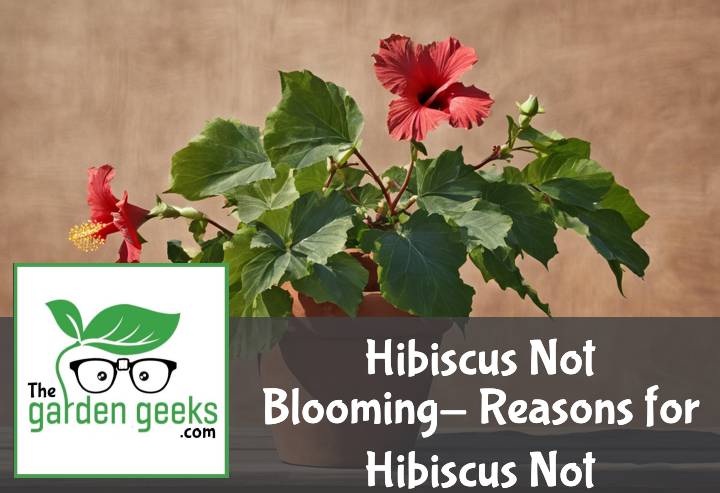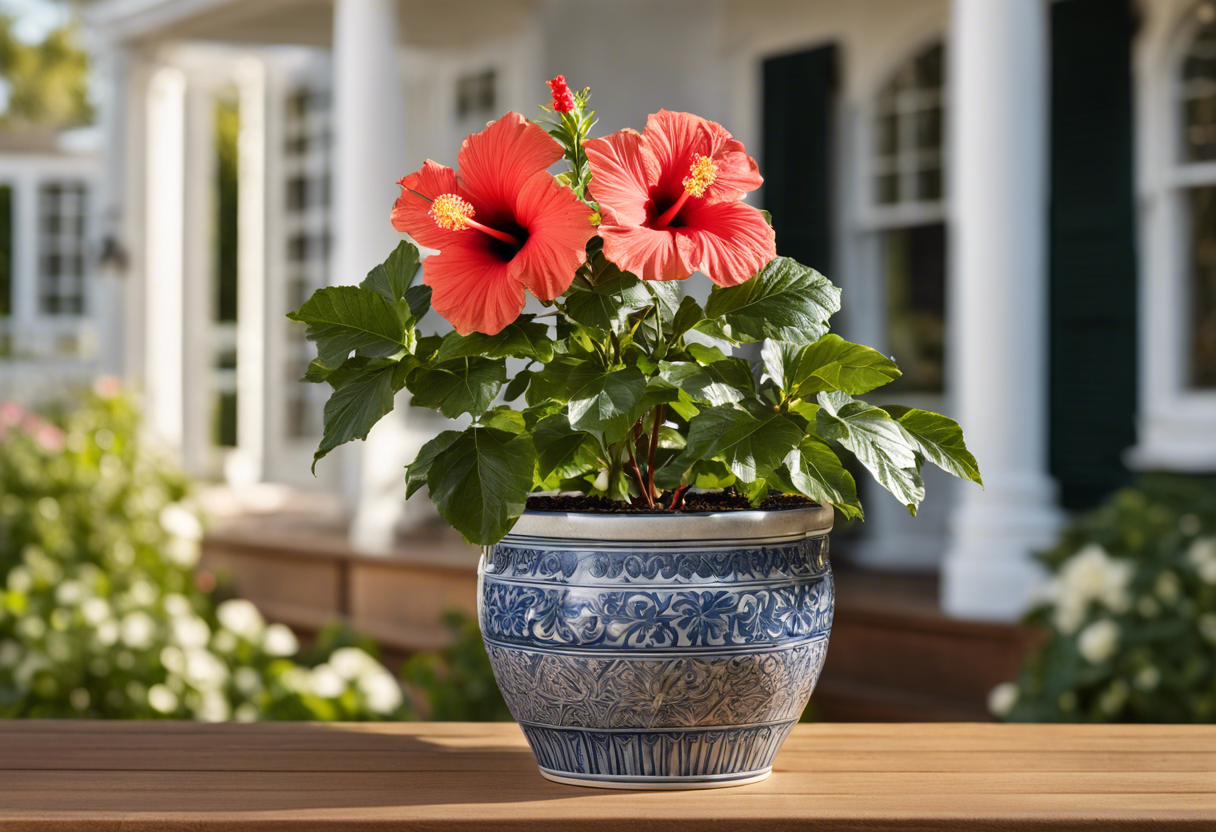Ever found yourself gazing at your garden, cup of coffee in hand, only to realize that your Hibiscus Not Blooming? Yeah, been there. It’s like hosting a party and the guest of honor decides not to show up. Quite a bummer!
But don’t fret! We’re here to help you understand why your hibiscus might be throwing such tantrums. So, sit back and buckle up as we delve into the reasons for ‘Hibiscus Not Flowering’. Keep reading!
Key Takeaways
- Hibiscus may not bloom due to insufficient sunlight; they need at least six hours of direct sunlight daily.
- Overwatering or underwatering can also prevent blooming; hibiscus prefers well-drained soil and regular watering.
- Incorrect fertilization can hinder flowering; a high potassium and low nitrogen fertilizer is ideal.
- Pests or diseases may affect the plant’s health, leading to non-flowering. Regular inspection and treatment are necessary.
- Pruning at the wrong time can remove budding sites, so it should be done in early spring.
What is Hibiscus?
Well, let me tell you about the hibiscus plant. It’s a stunner! With its bold, trumpet-shaped flowers and lush green leaves, it’s a real showstopper in any garden. But here’s the kicker – when your hibiscus is not blooming, it can be a real head-scratcher.
Brief Description of Hibiscus
The hibiscus is a pretty versatile plant. You’ve got your tropical hibiscus, and then there’s the hardy hibiscus. Both are beauties, but they have their own unique hibiscus characteristics.
The tropical variety loves warm climates and comes in a rainbow of colors. From fiery reds to cool blues, these guys know how to put on a show. On the other hand, hardy hibiscus can withstand colder temperatures and typically bloom in shades of pink or white.
Importance of Blooming in Hibiscus
Now, why all this fuss about blooming? Well, for starters, blooming is like the plant’s way of saying “Hey world! I’m healthy!” So when your hibiscus isn’t showing off those vibrant petals, it might be an SOS signal.
But beyond health benefits, there’s also the undeniable aesthetic appeal of blooming. A fully bloomed hibiscus is like a living piece of art that adds color and life to any space. So when your hibiscus is not blooming, you’re missing out on some serious eye candy!
Why is My Hibiscus Not Blooming?
Oh, the heartache when your hibiscus isn’t blooming! It’s like a summer without ice cream. Hibiscus not flowering can be due to several reasons such as lack of sunlight, inadequate watering, or incorrect temperature conditions. Let’s dive into these hibiscus bloom issues and start troubleshooting.
Lack of Sunlight
Sunlight plays a crucial role in the blooming process of hibiscus plants. When there’s a lack of sunlight in hibiscus, it’s like trying to bake cookies without an oven. Hibiscus needs at least 6 hours of direct sunlight daily. So if your plant is stuck in the shade, it might just pout and refuse to bloom due to this sunlight deficiency in hibiscus.
Inadequate Watering
Watering is another key factor for a happy blooming hibiscus. Too much water? Your plant drowns. Too little? It dehydrates. Both scenarios lead to hibiscus not blooming because of improper watering practices. The trick is keeping the soil moist but not soggy – think “moist chocolate cake” levels here.
Incorrect Temperature Conditions
Temperature swings can make your hibiscus more moody than a teenager on prom night! Hibiscuses are tropical plants and prefer temperatures between 60-90°F (15-32°C). If they’re exposed to too hot or too cold conditions, they might just give you the cold shoulder and stop flowering altogether due to these unsuitable temperature conditions.
How Does Soil Quality Affect Hibiscus Blooming?
Well, let me tell you, the quality of your soil is like the VIP pass for your hibiscus to bloom. It’s all about that perfect balance of pH and nutrients. If those two are off, it’s a no-go for blooming.
Importance of Proper Soil pH
Here’s the scoop on hibiscus soil pH requirements – hibiscus plants are picky eaters! They prefer their meals (or in this case, soil) slightly acidic. When the pH swings too high or low, it’s like eating a meal that’s too spicy or bland. It just doesn’t sit well with them and can prevent them from blooming. So remember folks, adjusting soil pH for hibiscus is not just important, it’s crucial!
Impact of Nutrient Deficiency
Now onto nutrients. Imagine trying to run a marathon without having eaten anything – tough right? That’s how your hibiscus feels when there’s a nutrient deficiency. Certain nutrients like potassium and phosphorus are key players in the blooming process. Without them, your hibiscus not blooming might become an unfortunate reality. So keep an eye out for signs of nutrient deficiency and don’t skimp on the fertilizer!
Can Pests and Diseases Prevent Hibiscus from Flowering?
Absolutely! Pests and diseases can play a major role in your hibiscus not blooming. These uninvited guests can cause significant damage, leading to flowering prevention. Let’s dive into the nitty-gritty of these pesky problems.
Common Pests that Affect Hibiscus
First off, let’s talk about aphids on hibiscus. These tiny critters suck the life out of your plant, literally! They feed on plant juices causing the hibiscus to weaken and prevent it from blooming.
Next up are whiteflies, another bunch of juice-sucking pests. They’re like tiny vampires for your hibiscus, leaving it too drained to produce flowers.
Then we have mealybugs and spider mites, both notorious for causing leaf damage which can impact blooming. And don’t get me started on thrips, they’re small but mighty when it comes to wreaking havoc!
Diseases that can Hinder Blooming
Moving onto diseases, one common culprit is fungal diseases in hibiscus. These fungi love damp conditions and can cause leaf spots or even root rot, which definitely puts a damper on any blooming plans.
Speaking of spots, bacterial leaf spot is another disease that can affect flowering. It causes unsightly spots on leaves which can lead to overall plant stress.
And then there’s the dreaded root rot, often caused by overwatering or poor drainage. This disease literally rots the roots, making it hard for the plant to absorb nutrients needed for flowering.
Lastly, if you notice yellow leaves on your hibiscus, it might be suffering from a disease aptly named “yellow leaves disease“. This condition weakens the plant and can prevent it from blooming. So, keep an eye out for these issues to ensure your hibiscus is always ready to put on a show!
How Does Pruning Influence the Flowering of Hibiscus?
Pruning is like a magic wand for your hibiscus. Done right, it can encourage your hibiscus not blooming to burst into a riot of colors. But if you goof up, well, let’s just say it won’t be pretty.
The Role of Pruning in Flower Production
When it comes to pruning hibiscus for flowers, think of it as giving your plant a little pep talk. You’re basically telling it, “Hey buddy, focus on making those gorgeous blooms!”
Proper pruning techniques can redirect the plant’s energy towards hibiscus flower production. It’s like giving the plant a roadmap to success.
But remember, with great power comes great responsibility! Overzealous pruning can stress out your plant and lead to less flowering or even no flowering at all.
Wrong Pruning Techniques and Their Effects
Now let’s talk about what happens when you don’t prune correctly. Improper pruning techniques are like a roadblock in your hibiscus’ journey towards blooming.
The effects of wrong pruning can range from reduced flowering to complete cessation of blooming. It’s like throwing a wrench in the works!
So remember folks, when it comes to encouraging hibiscus bloom, proper pruning is key! Don’t let bad pruning practices be the reason behind your hibiscus not blooming.
To Wrap Up
Like a diva in stage fright, your hibiscus might just need a little coaxing to bloom. Remember the main culprits: inadequate light, poor nutrition, and incorrect watering. Get these right and you’ll have a flower power show in no time!
For more tips on Hibiscus Not Blooming, hit that link. Let’s get those buds blooming, green thumbs!





